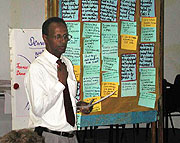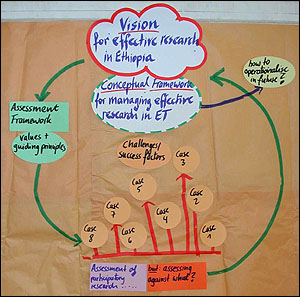







 |
 |

Self-Managed Change for Institutionalizing Integrated NRM
 |
|
 |
MANAGING "PARADIGM SHIFTS"

Dr. Abera Deressa, former DDG of the Ethiopian Agricultural Research Organization (EARO), presents group results on how to implement desired institutional changes.
 |
|
 |
Workshop participants discussing competencies needed to institutionalize the "Integrated Agricultural Research for Development" paradigm within EARO.
 |
|
INRM poses two primary challenges: developing and testing new approaches through pilot site research and learning with communities, development actors and policy makers, and enabling institutional innovations and reforms to enable more widespread support and utilization of these approaches. Most of AHI's self-led institutional change work has focused on partner National Agricultural Research Institutes (NARIs). Research organizations in eastern Africa have policies and procedures that often deter uptake of new methods that are people-centered and integrate expertise across multiple disciplines. Therefore, changing the internal working pattern and culture of organizations becomes fundamental to INRM, and the processes that enable this to happen need to be understood so that they can be managed.
 ASSESSING NEED FOR CHANGE ASSESSING NEED FOR CHANGE
During an AHI regional workshop, Participants from National Agricultural Research Institutes (NARIs) suggested that if INRM were widely applied, researchers would:
- Apply their skills to a broader range of topics; for example, on ways to improve local collective action for better environmental management; conflict resolution; managing a production-to-market chain; and influencing policy makers.
- Balance environmental management and enterprise development concerns.
- Use integrated, multi-disciplinary teams for solving complex issues.
- Employ strategic partnerships and improve inter-institutional links with development organizations, policy makers and the private sector.
- Work at multiple levels and scales with a wide variety of actors.
- Utilize a wide range of participatory methods that foster local ownership and stewardship of natural resources, particularly by engaging women and the poor, and build local capacity.
In 2001, AHI embarked on a collaborative initiative on self-directed management of organizational change. The initiative employed a self-reflection process within two NARIs, the Ethiopian Institute of Agricultural Research (EIAR) and the Department of Research and Development (DRD) of Tanzania. In 2004, the National Agricultural Research Organization (NARO) of Uganda joined the initiative, with an emphasis on institutional change within its Zonal Agriculture Development Centers. The reflection process consolidated interest in capturing past lessons in participatory research (PR) and integrated agricultural research for development (IAR4D).
 CONSOLIDATING EVIDENCE: DISTILLING THE VALUE AND NATURE OF CHANGE CONSOLIDATING EVIDENCE: DISTILLING THE VALUE AND NATURE OF CHANGE
The NARI managers of Tanzania and Ethiopia required evidence to ground their institutional change processes. Eight pilot projects in Ethiopia and Tanzania were jointly selected by workshop participants and subject to an in-depth exploration of the impacts stemming from participatory approaches. NARI expectations were to understand the potentials and constraints to PR, to produce a framework and guidelines for best practice and for impact assessment of research, and to formulate a strategy for operationalizing PR using newly acquired knowledge of related success factors. Steps in the assessment of participatory research case studies included:
- Discussion with research managers on their visions to build ownership of the assessment. This led to top managers within the pilot NARIs wanting to find out more about the added value of participatory research (PR) and how identified "best practices" might be integrated into research and organizational culture.
- Design of an assessment framework and methodology based on shared research standards.
- Field assessment of case studies. A cross-section of researchers from each organization undertook the PR assessment using this assessment framework, which ran concurrently in Tanzania and Ethiopia and focused on identification of impact areas, values and principles of PR.
- Analysis of information and documentation (see Stroud and Hagmann, 2004).
This process is captured in graphic form in Figure 1.

Figure 1. Outcome of group planning for an evaluation of participatory research experiences in Ethiopia
Key Success Factors
From the pilot cases studied in Ethiopia, successes with participatory research (PR) approach were attributed to:
- A supportive research management systems and organization
- Development of appropriate technologies and baskets of options
- Establishment of linkages among farmers, and between farmers and R&D institutions
- Engagement of farmers in actively searching for their own solutions to problems
- Opportunity to builds farmers' capacity in managing their resources
- Changing attitudes of researchers and institutions towards working with farmers
Key Barriers and Challenges
- Skills and capacity to implement PR
- Systematic documentation of PR processes
- Genuine representation of stakeholders in the PR process
- Design of strategies for dissemination and scaling up
- Mutual accountability among different stakeholders
- Inadequate attention to income generating products and market linkages
 INSTITUTIONAL CHANGE INSTITUTIONAL CHANGE
The third step of the self-led institutional change process has been action-based learning on institutional reforms, guided by the managers and senior scientists of two NARIs: the Ethiopian Institute of Agricultural Research (EIAR) and the National Agricultural Research Organization (NARO). These institutional reforms are carried out through an iterative process of reflection and planning (through externally-facilitated national workshops) and implementation (through participant agreements on new practices and procedures to be tested in their respective research centres).
Institutional Reforms in EIAR
Following identification of key success factors and barriers to participatory research, EIAR targeted the following modifications in institutional structure and practice:
- Proposal development, review and project management. The emphasis has been to improve coordination so as to minimize disciplinary competition, and to strengthen the focus through the division of labour based on expertise and competence. shifting from individual planning and implementation to interdisciplinary teamwork, with teams of senior scientists developing core research ideas and assigning sub-tasks to individuals.
- A shared understanding of EIAR's vision and its implications for the way of doing business. The vision and strategy emphasized effective, impact-oriented research.
- A closer working relationship between regional and national research institutes and institutions of higher learning. The idea is to minimize duplications and create an improved flow of germplasm, skills and technologies between the various levels of research within the country.
- Innovation systems. A new approach to institutional innovation is being targeted to enable a more efficient and responsive process of technology development.
In 2004-2005, a series of workshops with EIAR management plus research center directors were convened to develop action plans to address identified barriers. A core team consisting of EIAR managers, center directors and representatives from regional research institutes was formed to sustain dialogue and coordination with regards to capacity and methodology development; partnership strategies; researcher-farmer interactions and matching technology demand to supply; the value system underlying organizational practices; understanding and commitment of researchers to impact orientation; and alignment of resources, mechanisms (incentive and reward systems, planning and monitoring) and structures to new priorities.
The following challenges, encountered during early stages of institutional reform, are guiding institutional innovations within EIAR:
- Aligning technological options with appropriate domains, innovation systems and markets
- Integration of stakeholders, expertise and institutions to work together on common goals and innovations
- Strengthening farmer involvement in R&D, farmer experimentation and scaling up
- Establishing a knowledge and information management system in EIAR
- Institutionalizing M&E as a system to learn and improve the way of doing business
- Intensifying scaling up of knowledge and technologies
- Motivating researchers to commitment themselves fully and broaden their research endeavors
- Enhancing policy development and implementation processes which build on the reality on the ground
Strong leadership at top levels of management and national political commitment have catalyzed strong institutional innovations within EIAR that extend well beyond self-led institutional change processes catalyzed by AHI, and are in turn giving shape to AHI's contributions.
Institutional Reforms in NARO
Since 2003, NARO has been involved in institutional reform processes following policy change in agriculture research. These changes hinge upon:
- A theme-based structure that is innovative and better able to respond to the demands of clients.
- An integrated agriculture research for development (IAR4D) approach that moves beyond production and emphasizes strengthening of human and institutional capacity for impact-oriented research.
- Creation of automonous zonal research and development institutes to respond to local research priorities.
- Competitive zonal research funds geared towards addressing zonal research and development priorities.
In 2004 and 2005, training and review workshops were convened to operationalise the reform process within NARO in collaboration with Makerere and ICRA. So far, the following advances have been made in institutional reforms, coordinated by the Deputy Director for Outreach in NARO:
- Zonal research teams have been trained in the IAR4D approach;
- The competitive grants scheme is being piloted and will be scaled up based on the lessons from the field.
- Research themes have been reformed and theme leaders assigned to ensure integration of the themes and alignment with NARO and government research policy;
- Integrated learning teams consisting of representatives from NARO, local government, Makerere University and AHI have been formed, exposed to concepts and principles of IAR4D, encouraged to innovate in the application of knowledge gained, and given follow-up to capture lessons and challenges and jointly troubleshoot.
- A mentor and facilitation team consisting of Makerere, NARO and AHI researchers has been formed to ensure continuity and quality in the implementation of agreed action plans, and a Planning and Implementation Team (PIT) established to ensure learning events and field work proceed according to the plans and are reported to the NARO Steering Committee.
Through each of the above changes, a common understanding of the new way of doing business has emerged, allaying initial skepticism of the process. However, key challenges have also been faced, including:
- Development of effective partnerships for IAR4D
- Mechanisms to motivate staff for effective performance
- Strategies to enhance farmer participation in the research process
- Structuring and sustaining multidisciplinary teams
- Strengthening skills and interest in policy research
- Writing competitive research proposals
- Strengthening monitoring and evaluation systems
The iterative planning, action and review process, ongoing mentoring of field teams and commitment of NARO leadership will ensure that above challenges serve as the driver to institutional learning and innovation in the months and years ahead. Other plans include capacity building for entire research stations on the principles of IAR4D (market chain analysis, participatory monitoring and evaluation, proposal development, stakeholder analysis and team-building) and capturing of lessons from the pilot phase to scale up successful institutional innovations.
 |
 |